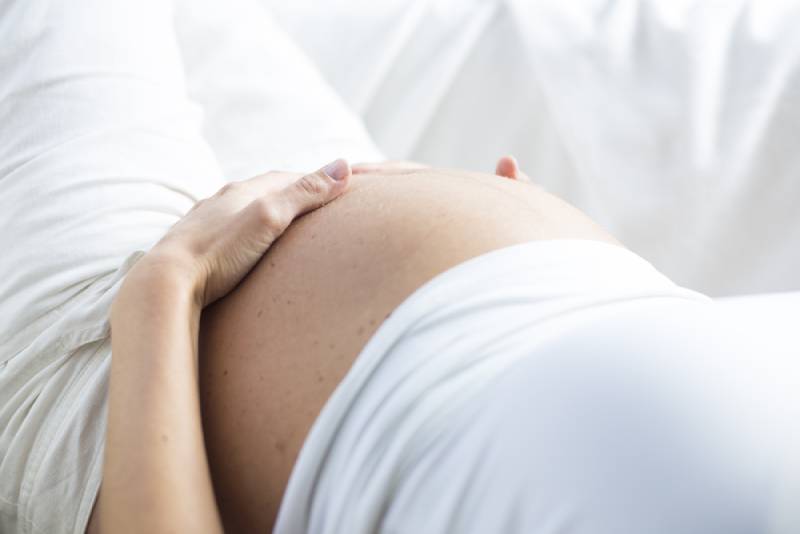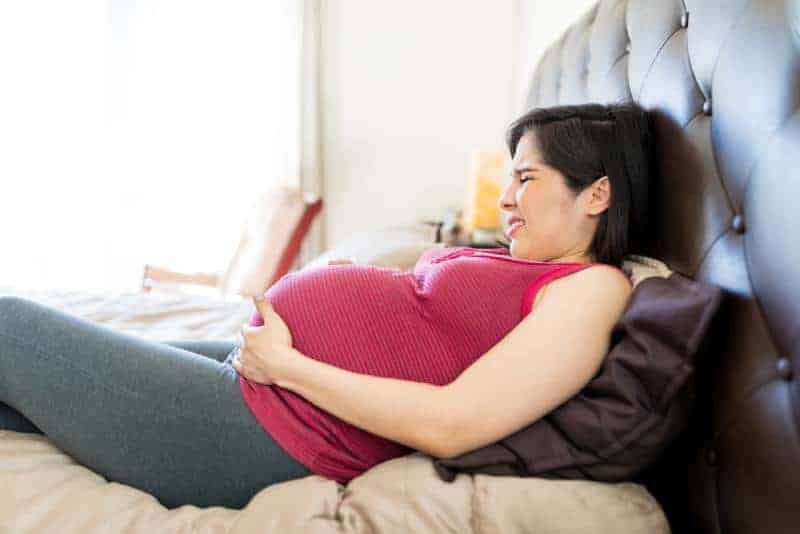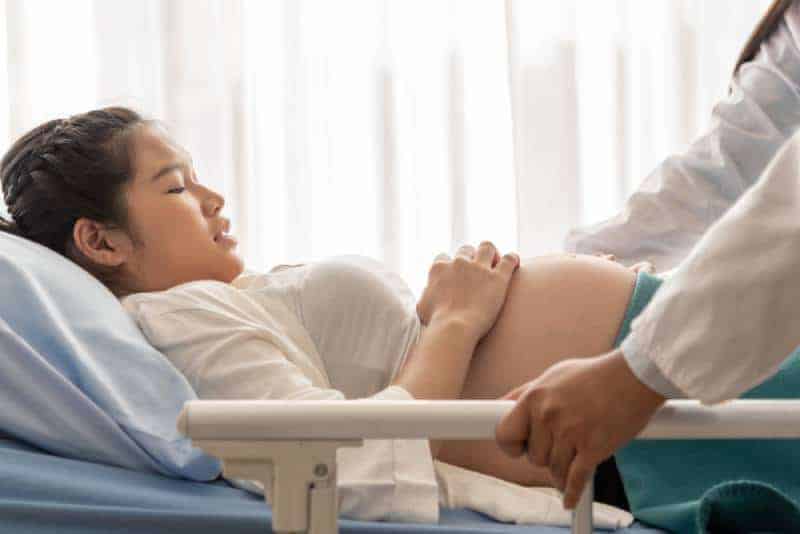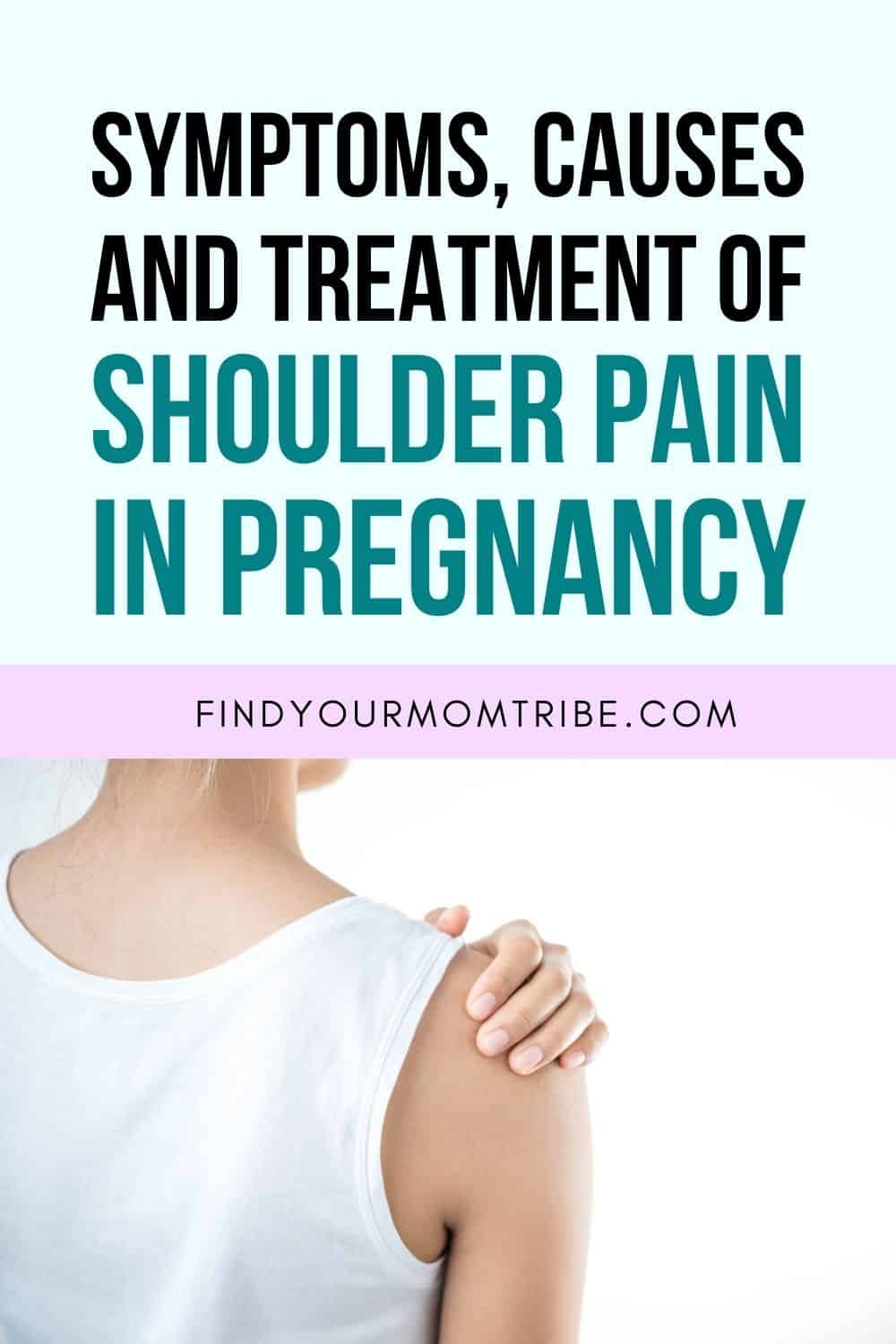The last thing pregnant women think of when concerning themselves with pregnancy woes is shoulder pain in pregnancy.
Though it may come as a surprise, shoulder pain in pregnancy is quite common and a good indicator of potential problems.
Some tend to be more of a nuisance than anything while others can turn into quite an issue.
Most of the time, the main culprit, at least for milder problems, is the hormone, relaxin.
This is the one responsible for loosening the connective tissue in our joints, causing the dull pain we can feel when experiencing regular shoulder pain.
But sometimes, it can be an indicator of something else. Shoulder pain can function as a warning sign that something is awry, especially if the pain starts to intensify or is followed up by some other symptoms.
Luckily, the causes of shoulder pain in pregnancy are somewhat predictable based on the period in which they occur.
The first trimester’s biggest concerns are either an ectopic pregnancy or a tubal one.
As for the second and third trimesters, the problem can be either gallstones or worse, preeclampsia.
All four of these are rather severe, some are even potentially life-threatening.
This is why it’s always important to check in with your doctor or any other health care provider if you start feeling more severe shoulder pain during pregnancy.
Symptoms Of Shoulder Pain In Pregnancy

While shoulder pain is a symptom that leads to further complications, it is not an indicator in itself. Other symptoms are usually present for it to have a direct link to the underlying condition.
These symptoms are:
• Sudden weight gain
• Nausea
• Fainting
• Vomiting
• Dangerously low/high blood pressure
If you experience any of these alongside your shoulder pain in pregnancy, make sure to get it checked out just in case there might be more to it.
Causes Of Shoulder Pain In Pregnancy
As mentioned at the start of the article, shoulder pain in pregnancy is usually caused by something minor like a soreness that comes from relaxed joints.
However, sometimes it can come from something more severe like preeclampsia, indicated by other symptoms.
The general cause

The most common causes of shoulder pain are going to be related to your posture or excessively straining your body.
These are all common problems during pregnancy since most of us take some time to adjust to the whole ‘being pregnant’ lifestyle, and think we can do everything we used to while also caring for a baby.
While knowing how and when to relax is going to help remedy some of these common problems, there’s another culprit at play here, and that’s the aforementioned hormone, relaxin.
Its production increases during a pregnancy as the body is slowly prepared to deliver the baby over the course of the pregnancy.
While its main purpose is to help loosen your pelvic bones to make space for the baby during childbirth, it can’t exactly be channelled to only one place.
That’s why it ends up affecting other areas, like the joints in your lower back and your shoulders. What’s more, as the influence of relaxin increases, so too do the effects of it on your body throughout the pregnancy.
First trimester changes

As far as relaxin’s influence goes, you shouldn’t be experiencing too much trouble, only some minor lower back pain, light chest pain or pain in your left and right shoulder joints and their respective shoulder blades.
But, that’s mostly because your body will slowly start becoming tender and more sensitive to sleeping in weird positions as well as poor posture.
The more serious problems that you should be wary of during the first trimester are the ectopic and tubal pregnancies.
An ectopic pregnancy is a rather serious condition: the embryo gets stuck in the Fallopian tube or somewhere else on its way to the uterus and starts growing there.
This improper growth starts causing serious problems for the mother and can cause life-threatening bleeding problems.
One of the early warning signs that you might be going through an ectopic/tubal pregnancy is a sharp stabbing pain right in the ligament where the shoulder and the arm connect. This is a major red flag.
Other symptoms include:
• Pain on the left or right side of your body
• Nausea
• Light vaginal bleeding
• Vomiting
• Pelvic and rectal pain
• Diarrhea
• Abdominal pain during bowel movements
• General weakness and dizziness
Should you start feeling any combination of these, make sure to seek immediate medical attention to intervene in time and help prevent the problem developing into a more serious one.
The specific one that you want to avoid is your Fallopian tubes rupturing or bursting, or the internal bleeding becoming too severe.
The most common risk factors that increase the chances of having an ectopic pregnancy arise from using various forms of birth control like IUDs, a different form of conception, such as an IVF, or if you are suffering from an STD.
Even age affects the chances as women older than 30 are more likely to suffer from an ectopic pregnancy.
Second trimester changes

During the second trimester, you’ll find that the effects of relaxin have started to sink in a bit further as your body might feel somewhat off.
As your tummy starts growing you’ll also notice how much harder it is to control your body.
Not because of the slight weight gain mind you, but more due to a slightly shifted center of gravity and loosened joints.
You’ll start feeling more dull aches, not just in the ligaments in your shoulders and elsewhere, but in your muscles as well. It’ll feel like you’re more water than woman in some cases.
It can take some time to get used to it, after which you’ll start feeling a bit better and these problems become a lot more bearable.
In the meantime, don’t forget to get more bed rest than you’re normally accustomed to in case you start feeling too much pain.
Third trimester changes

The third trimester is where it gets a bit trickier. The relaxin has kicked in so much that your entire body is starting to shift, especially your pelvic area and your spine.
The pelvic area is becoming a lot looser, making it a lot more flexible for when the due date comes.
The other, however, is because the spine needs to adjust so that you can carry the baby better, adapting to that shifted center of gravity I mentioned earlier.
It starts resembling a sharper “S” than it does in non-pregnant women.
Though this change doesn’t come without consequences.
Thankfully, these are only minor ones and most of them are only going to cause minor shoulder pain and back pain as they further adjust to better suit the body’s purpose at the time.
All your other joints will still feel like they weren’t screwed on fully, making you feel wobbly. This feeling should last for a few weeks postpartum and should gradually fade.
However, the second and third trimesters aren’t without their problems either. Namely, two rather serious ones, gallstones and preeclampsia.
Gallstones
Gallstones, while not as life threatening as an ectopic pregnancy or preeclampsia, can still cause quite the stir in your body.
Normally, they’re often caused by poor dietary choices, but during pregnancy, it’s the pregnancy hormones that are responsible for the increased chances of them appearing, namely estrogen among others.
And it happens because the function of the gallbladder slows down, giving more time for them to form.
Gallstones are made from a mixture of concentrated bile and water, fat and some other things that form into lumps of varying sizes.
Lumps that can cause various blockages will lead to sharp abdominal pain and a so-called gallbladder attack, a problem where the gallbladder becomes clogged up, leading to a buildup of bile which ends up causing a gut-wrenching pain.
One so intense that you might find yourself unable to move.
Symptoms of gallstones

The pain in your gallbladder is but one of the symptoms that tell you if you’re suffering from gallstones or not
Other symptoms include:
• Upper back pain around the shoulder blade area
• Vomiting
• Itching
• Progressively worse abdominal pain either in the middle or the right side
• Nausea
• Fever
• Jaundice
The worst part is that its symptoms can easily be confused with regular pregnancy symptoms.
This is mostly because some women tend to disregard them and end up having further complications that can result in an intervention.
This usually means having to undertake invasive surgery to get the gallstones removed.
That said, you might end up having to wait if the problem occurs late into the third trimester due to the growing uterus presenting an obstacle that poses an unwanted risk.
Do make sure to schedule an appointment with your doctor or any other qualified health care provider should you start experiencing these symptoms, however.
Medical attention should be sought, not just for the gallstones themselves, but because severe abdominal pain can also be an early warning sign of acute appendicitis that, if left unchecked, can have fatal consequences.
Treating gallstones

As far as gallstones themselves go, you can help reduce your chances of these complications by maintaining a healthier diet.
This means sticking to a more regular meal plan, replacing all the sweet and sugary stuff we love so much, as well as any simple carbs and fried foods because these are the things that massively contribute to its occurrence.
But, you should also make sure to introduce more fiber to your diet in general, even more so than usual during a pregnancy.
You’d also do well to get some light exercise in to keep your metabolism rolling at a steady pace.
For some more personalized medical advice on the matter, I suggest asking your doctor.
They’ll be sure to know more about what you personally need to help prevent gallstones from forming.
Preeclampsia
Preeclampsia is one of the most dangerous and most common severe issues in pregnancy that comes with shoulder pain as one of its symptoms.
Causes

It’s most common cause is that of high blood pressure, also known as hypertension that occurs specifically due to developments during your pregnancy.
These developments normally include damage to the liver or some other organ and can become a rather big issue if they occur too early during a pregnancy.
Other causes can be due to insufficient blood flow to the uterus or some problems that impair the effectiveness of your immune system.
The normal form of preeclampsia can occur as early as 20 weeks into a pregnancy while the other, rarer, form of postpartum preeclampsia can develop shortly after the delivery of the baby.
Symptoms of preeclampsia

Other symptoms outside of high blood pressure include:
• Proteinuria (too much protein in urine, signified by a fruity smell of the urine and having it appear foamy)
• Edema (swelling of either the hands of the face)
• Painful headaches
• Vomiting
• Upper abdominal pain around the right side of your chest
• Nausea
• Fatigue and overall shortness of breath due to fluid appearing in the lungs
• Peeing less frequently
• Light sensitivity
• Thrombocytopenia (a low number of platelets in blood)
• Blurred vision or temporary loss of vision
• Suboptimal liver function
• Abnormal weight gain
As you can see, preeclampsia comes with a whole number of different symptoms, some of which can be confused with the typical symptoms of a pregnancy.
However, that doesn’t mean that they should be disregarded.
Frequent check-ups with your health care provider are important for this very reason as it’ll allow you to get more insight into what’s going on with your body and will allow for early detection of such problems.
The biggest early warning sign is elevated blood pressure for more than four hours during the day.
And the solution might end up being the need for an early birth which is why getting preeclampsia early can become a really tricky issue.
Luckily, that’s only in the worst case scenario.
What contributes to the appearance of preeclampsia?

As with many other things, there are several risk factors that play into an increased occurrence of this nasty complication.
Many of these are tied to some aspects of your pregnancy.
Risk factors tied to the pregnancy itself
For instance, you have a higher chance of developing preeclampsia during your first pregnancy than your future ones.
Some people believe it’s due to the initial shock that your body receives, one that it still hasn’t gotten used to handling quite yet.
Another cause might be due to carrying more than one baby.
Think twins, triplets or even more. All of that provides a heavy strain on the mother and leads to increased chances of this problem appearing.
If you don’t allow your body to recover from a prior pregnancy (usually a 24 month period) your body may be at risk of preeclampsia and some worse complications too, potentially fatal ones.
Another odd risk factor can also be the introduction of a new partner due to the different genetic material that the body isn’t used to.
Genetic risk factors
If your family line has had a history of preeclampsia, you’re more likely to have it develop than those who don’t.
Also, if you’re already suffering from chronic hypertension, your chances of it occurring are much higher by default.
The same goes for any potential liver and kidney problems you might’ve had prior to your pregnancy.
Other risk factors
There are a few other problems that might contribute to it. Some are avoidable, some much less so.
The one avoidable one is obesity.
Women who suffer from obesity are more likely to develop preeclampsia than those who have a standard BMI.
Meanwhile, the two unavoidable ones are that of age and race.
Namely, you’re more likely to get it if you’re over the age of 35 and that’s just an inevitability unless we find a way to stop aging.
The other unavoidable risk factor is that of race. While a cruel fact, women of African-American descent have a slight predisposition for developing preeclampsia due to a slightly different genetic makeup.
Why is preeclampsia so dangerous?

Preterm birth
The main reason is because of preterm birth, which might end up causing a number of problems for the baby and might lead to him needing extended incubator use and a number of other problems.
That said, it will end up saving both his life and yours in the process.
Fetal growth restriction
Along the same vein, the problem with this specific complication can be that the placenta isn’t receiving enough oxygen and nutrients through the blood, leading to lower birth weight and other problems for the child.
This is known as a fetal growth restriction.
HELLP syndrome
Another development that might happen if preeclampsia goes unchecked is the occurrence of the HELLP syndrome, an elevated form of the condition that has similar symptoms, but it also begins damaging more internal organs.
All of this will require immediate medical attention and will put you in life-threatening danger.
Increased chance of suffering from cardiovascular diseases
After going through this troublesome condition, you might become more prone to some other cardiovascular diseases as well, especially if you’ve had it multiple times through multiple pregnancies.
Luckily, this can be somewhat controlled by maintaining a healthy lifestyle.
Organ damage
It’s not just the HELLP syndrome that can cause organ damage, the initial problem itself can too, especially to the liver, heart and kidneys as well as your lungs. If left unchecked, it can wreak complete havoc and cause irreversible damage.
Placental abruption
Finally, preeclampsia might even end up causing your placenta to detach from the uterine wall too early, a complication called placental abruption.
This can end up causing some heavy bleeding and will most likely lead to a preterm birth and is one of the most serious issues of this condition.
Treating preeclampsia

If detected early, only a few simple lifestyle changes are needed.
You can do things like getting plenty of bed rest, booking frequent check-ups so your doctor can monitor the progress of the problem, lowering the amount of sodium in your diet and measuring your blood pressure at home.
On top of that, you might get some medication prescribed to you by your doctor to help keep the situation in check.
Some calcium supplements can help if the cause of your preeclampsia is a lack of calcium in the diet.
That said, the more common medication that pregnant women get prescribed is a low-power aspirin, one that’s safe to take during pregnancy.
Treating Shoulder Pain In Pregnancy

Given how bothersome shoulder pain can normally be, let alone how much worse it feels during a pregnancy, treating it should be a priority.
But, seeing as how tender our body gets during this period, not every method can work.
For instance, most painkillers are usually not recommended as they’ll do more harm than good to the baby.
But, there are other methods that do work.
The important things that you should look at are physical therapy, rest and light exercise.
Going to a chiropractor can get you so much needed relief when dealing with shoulder pain in pregnancy.
Do make sure that they’re certified for dealing with pregnant women before scheduling an appointment as not all of them are.
The other, less expensive things that you can do are to stay somewhat active.
This relates to getting some daily walking and light exercise to keep your body in regular shape.
Think things like yoga or just some daily stretching so you don’t curl up like a pretzel.
And, of course, not straining yourself too hard by trying to do something that applies too much pressure on your shoulders.
Your top priority should be to rest. Get the daily 6-8 hours in so your muscles (and your body and mind as a whole) get time to relax and relieve physical and mental stress.
Do make sure that it’s your doctor who prescribes them to you. Don’t go off taking them preemptively.
That’s the last thing you should be doing because you might not even need them or they might even be bad for you in your current state due to some other underlying problems.
Leave it in the hands of professionals. They know what they’re doing and the health and the safety of your future child is their number one priority at that time.
Summing It All Up
Shoulder pain in pregnancy, while a nuisance, is most often harmless and is caused by the hormone, relaxin, spreading throughout the body.
However, it can also be an early warning sign for some really problematic conditions that can develop during a pregnancy like ectopic pregnancy, the appearance of gallstones and, the worst one of them all, preeclampsia.
Make sure to do frequent prenatal check-ups with your doctor and health-care provider to detect them early.
You don’t want them to become too big a problem that might end up endangering your health and the health of the little one in your womb.
As far as the pain in your shoulders and the rest of your body goes, I recommend booking regular sessions at the chiropractor to help set things back into place gently and to help dissipate the pain and discomfort.
Do make sure to go to ones that are certified to work with pregnant women because you’ll need special care when dealing with massages and the like.
Make sure to stay safe so that both you and your little one can end up safe and healthy at the end of the pregnancy.
Like this post? Please share or pin it for later. You can also stay in the loop and follow us on Facebook, Instagram and Pinterest.

This post contains affiliate links. Please see our full disclosure for more info.

